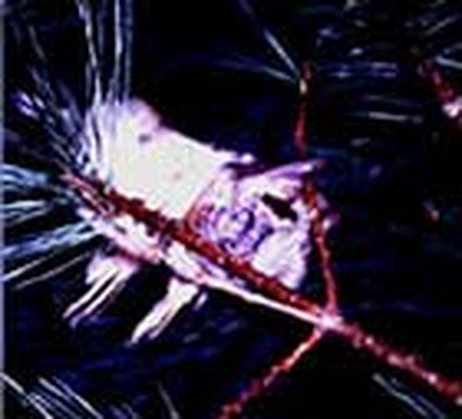
Biologist Bernd Heinrich made dozens of attempts to follow kinglets to their roosts at night before he finally found a group huddling together.
Before you start reading this, grab a nickel out of your piggy bank and hold it in the palm of your hand. Golden-crowned kinglets are the smallest birds to winter in the New England woods. They weigh as little as that nickel sitting in your palm, and they are not much bigger than your thumb. How does a bird this small stay alive during the long winter night, with little to fuel its metabolic flames?
Larger animals have a lower surface-to-volume ratio than smaller animals. As a result, they radiate less body heat per unit of mass and are therefore able to stay warm using less energy. In 1847, Dr. Karl Bergmann, a German biologist, used this principle to show that within most warm-blooded species, body mass increases with latitude and colder climates.
Kinglets, therefore, would seem to be at a disadvantage when it comes to surviving in cold, higher latitude climates.
To make kinglets even stranger, they only eat insects. You’ll never see one at your bird feeder. Nuthatches and chickadees – two of our other small, over-wintering species – eat insects, but they also eat seeds and suet, which are higher in fat and calories than insects. Most insectivorous birds of the North Woods, of course, avoid the problem of staying warm altogether by heading south when insects become scarce. Not kinglets.
Birds generally need to maintain a core body temperature of around 104ºF, year ‘round. This high temperature allows for powered flight and quick movements and reflexes. But this high temperature also requires a large amount of fuel.
University of Vermont scientist Bernd Heinrich wondered what kinglets were eating in the winter to keep the metabolic flame burning. He found that although they are fairly opportunistic, eating everything from spiders to insect eggs, they subsist primarily on moth caterpillars found over-wintering on trees. He collected some of the caterpillars and kept them in his freezer for the rest of the winter. In the spring, he took them out and thawed them, then raised them to adulthood so that they could be identified more readily. They turned out to be one-spotted variants, a well-known moth whose over-wintering spot had not previously been known?
But this was only half the story. Researchers in Virginia calculated that kinglets could only build up enough fat during a day of foraging to fuel their metabolism for half the night. Even with their ability to find plenty of insect food in the seemingly sterile winter woods, they would be unable to stay warm throughout the night based solely on their daytime diet.
Several biologists had suggested that kinglets survive by sleeping in shelters such as old squirrel or bird nests or by huddling together. Enter the ever-inquisitive Heinrich again. After dozens of attempts to follow kinglets foraging in late afternoon and evening, he was finally successful during twilight one December evening. Heinrich reported his observation in the Wilson Bulletin, a journal of ornithology.
“At 4:20 P.M. I saw three kinglets fly into a brushy white pine. In less than a minute, I found four kinglets huddled together about four meters above the ground under thick branches.”
He returned an hour later with a stepladder and a camera. The birds remained huddled together through the night with their heads tucked into their back feathers and just their tails sticking out of the feathery fluff. The temperature went down to 14ºF.
Kinglets, like other northern birds, are also able to recapture heat that would otherwise be lost through the skin of their non-feathered legs and feet. In addition to simply tucking their extremities into their thick body feathers while sleeping, birds have a vascular system in which arteries carrying warm blood out to the legs are located close to veins carrying the cool blood back to the body, allowing heat to be retained. The design is so effective that we humans use similar, artificial heat exchangers to recapture heat in all sorts of applications.
Heinrich also found that sleeping kinglets fluff up their feathers to make an inch-thick, downy blanket. His experiments showed that without this down comforter, a naked kinglet would cool 250 times faster than one fully feathered. He weighed the wing and tail feathers, which are primarily used for flying, and compared them to the weight of the body feathers, which are primarily used for insulation. Kinglets have four times more feather mass committed to insulation than to flying.
The smallest winter bird in the North Woods thus transforms itself into a much bigger bird at night, thereby creating a lower surface-to-volume ratio. Puffed-up kinglets radiate less body heat per unit of mass, enabling them to conserve energy and survive the long and frosty New England nights.
Comments (7)
Pingbacks (2)
-
[…] or bird nests and huddle together to stay warm, he found after following several to their roost one December twilight. Like me in my coat, sleeping kinglets fluff up their feathers to make an inch-thick, downy […]
-
[…] Kinglets in the cold, Bernd Heinrich: https://vtecostudies.org/blog/kinglets-in-the-cold/ […]

Cool article
Fascinating! Thanks for another great entry.
Inspiring short video of Heinrich’s running passion (produced by Salomon), with scenes from his cabin in Maine: http://www.youtube.com/watch?v=zn6k3gXCszE
Terrific overview of this amazing creature. Thanks, Ted
Thanks Ted. Let’s get out in spring together for a little bird watching and see these guys in person! Have a great new year! Kent
This bird is so small but so fast and so cool!
Thank You Ted for your research on this amazing bird
Yeah